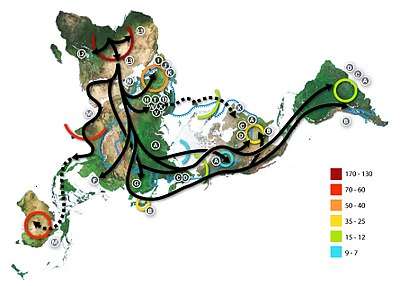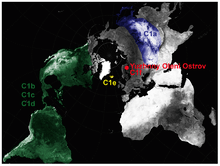Haplogroup C (mtDNA)
| Haplogroup C | |
|---|---|
 | |
| Possible time of origin | 23,900 YBP |
| Possible place of origin | Central Asia |
| Ancestor | CZ |
| Descendants | C1, C4, C5, C7 |
| Defining mutations | 489 10400 14783 15043[1] |
In human mitochondrial genetics, Haplogroup C is a human mitochondrial DNA (mtDNA) haplogroup.
Origin
Haplogroup C is believed to have arisen somewhere between the Caspian Sea and Lake Baikal some 24,000 years BCE. It is a descendant of the haplogroup M.
Distribution


Haplogroup C is found in Northeast Asia[2] (including Siberia). In Eurasia, Haplogroup C is especially frequent among populations of arctic Siberia, such as Yukaghirs and Nganasans.[3] Haplogroup C is one of five mtDNA haplogroups found in the indigenous peoples of the Americas,[2] the others being A, B, D, and X. The subclades C1b, C1c, C1d, and C4c are found in the first people of the Americas. C1a is found only in Asia.
In 2010, Icelandic researchers discovered C1e lineage in their home country, estimating an introduction date of year 1700 AD or earlier, indicating a possible introduction during the Viking expeditions to the Americas. A Native American origin for this C1e lineage is likely, but the researchers note that a European or Asian one cannot be ruled out.[4][5][6]
In 2014, a study discovered a new mtDNA subclade C1f from the remains of 3 people found in north-western Russia and dated to 7,500 years ago. It has not been detected in modern populations. The study proposed the hypothesis that the sister C1e and C1f subclades had split early from the most recent common ancestor of the C1 clade and had evolved independently. Subclade C1e had a northern European origin. Iceland was settled by the Vikings 1,130 years ago and they had raided heavily into western Russia, where the sister subclade C1f is now know to have resided. They proposed that both subclades were brought to Iceland through the Vikings, however C1e went extinct on mainland northern Europe due to population turnover and its small representation, and subclade C1f went extinct completely.[7]
In 2015, a study conducted in the Aconcagua mummy identified its mtDNA lineage belongs to the subclade C1bi, which contains 10 distinct mutations from C1b.[8]
Subclades
Tree
This phylogenetic tree of haplogroup C subclades is based on the paper by Mannis van Oven and Manfred Kayser Updated comprehensive phylogenetic tree of global human mitochondrial DNA variation[1] and subsequent published research.
- CZ
- C
- C1
- C1a
- C1b
- C1b1
- C1b2
- C1b2a
- C1b3
- C1b4
- C1b5
- C1c
- C1c1
- C1c2
- C1d
- C1d2
- C1d2a
- C1d2
- C1e
- C4
- C4a
- C4a1
- C4a1a
- C4a2
- C4a1
- C4b
- C4b1
- C4b1a
- C4b2
- C4b1
- C4c
- C4a
- C5
- C5a
- C5b
- C5b1
- C5c
- C5c1
- C5c1a
- C5d
- C5a
- C7
- C7a
- C7a1
- C7a1a
- C7a1c
- C7a1d
- C7a2
- C7a2a
- C7a1
- C7b
- C7a
- C1
- C
Popular culture
In his popular book The Seven Daughters of Eve, Bryan Sykes named the originator of this mtDNA haplogroup Chochmingwu.
See also
| Wikimedia Commons has media related to Haplogroup C (mtDNA). |
- Genealogical DNA test
- Genetic Genealogy
- Human mitochondrial genetics
- Population Genetics
- Human mitochondrial DNA haplogroups
- Indigenous American genetic studies
|
Phylogenetic tree of human mitochondrial DNA (mtDNA) haplogroups | |||||||||||||||||||||||||||||||||||||||
| Mitochondrial Eve (L) | |||||||||||||||||||||||||||||||||||||||
| L0 | L1–6 | ||||||||||||||||||||||||||||||||||||||
| L1 | L2 | L3 | L4 | L5 | L6 | ||||||||||||||||||||||||||||||||||
| M | N | ||||||||||||||||||||||||||||||||||||||
| CZ | D | E | G | Q | O | A | S | R | I | W | X | Y | |||||||||||||||||||||||||||
| C | Z | B | F | R0 | pre-JT | P | U | ||||||||||||||||||||||||||||||||
| HV | JT | K | |||||||||||||||||||||||||||||||||||||
| H | V | J | T | ||||||||||||||||||||||||||||||||||||
References
- 1 2 van Oven, Mannis; Manfred Kayser (13 Oct 2008). "Updated comprehensive phylogenetic tree of global human mitochondrial DNA variation". Human Mutation. 30 (2): E386–E394. doi:10.1002/humu.20921. PMID 18853457. Retrieved 2009-05-20.
- 1 2 Haplogroup C.
- ↑ Volodko, Natalia V.; Starikovskaya, Elena B.; Mazunin, Ilya O.; et al. (2008). "Mitochondrial Genome Diversity in Arctic Siberians, with Particular Reference to the Evolutionary History of Beringia and Pleistocenic Peopling of the Americas". The American Journal of Human Genetics. 82: 1084–1100. doi:10.1016/j.ajhg.2008.03.019.
- ↑ Sunna Ebenesersdóttir, Sigríður (2010). "A new subclade of mtDNA haplogroup C1 found in icelanders: Evidence of pre-columbian contact?". American Journal of Physical Anthropology. 144: 92–99. doi:10.1002/ajpa.21419.
- ↑ Vikings brought Amerindian to Iceland 1,000 years ago: study, November 17, 2010
- ↑ First Americans 'reached Europe five centuries before Columbus voyages', 16 Nov 2010
- ↑ Der Sarkissian, Clio; Brotherton, Paul; Balanovsky, Oleg; Templeton, Jennifer E. L.; Llamas, Bastien; Soubrier, Julien; Moiseyev, Vyacheslav; Khartanovich, Valery; Cooper, Alan; Haak, Wolfgang (2014). "Mitochondrial Genome Sequencing in Mesolithic North East Europe Unearths a New Sub-Clade within the Broadly Distributed Human Haplogroup C1". PLoS ONE. 9 (2): e87612. doi:10.1371/journal.pone.0087612. PMC 3913659. PMID 24503968.
- ↑ Gómez-Carballa & Catelli 2015.
Bibliography
- Gómez-Carballa, Alberto; Catelli, Laura (November 12, 2015). "The complete mitogenome of a 500-year-old Inca child mummy". Scientific Reports. 5. doi:10.1038/srep16462.
External links
- General
- Ian Logan's Mitochondrial DNA Site
- Mannis van Oven's Phylotree
- Haplogroup C